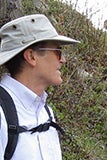Thursday, March 20, 2014 2:00 pm
-
3:00 pm
EDT (GMT -04:00)
John R. Kirtley, Stanford University
Scanning SQUID Microscopy of Topological Insulators

Topological insulators (TI) are materials that, under certain conditions, are insulating in the bulk but conducting on their surfaces, with quantized, spin polarized conduction. This quantum spin Hall effect has been experimentally confirmed using macroscopie transport measurements. Proximity of a topological insulator to a superconductor (S) is predicted to induce exotic quantum phases. We used a scanning SQUID microscope, which sensitively images the magnetic fields above a surface, to image the bulk and edge currents in HgTe quantum wells in the quantum spin Hall regime,1 and to determine the relationship between the Josephson supercurrent (Is) and the quantum mechanical phase difference (φ) in junctions with topological insulators as the insulating barrier between conventional superconductors.2 We find that the edge and bulk currents coexist in the quantum spin Hall regime over a large range of electrical gating conditions and temperature, and that the Is(φ) characteristic in S-TI-S junctions can be highly unconventional. Both results provide input to the question of how ballistic transport may be limited in topological insulators.
1. Katja C. Nowack et al., Nature Materials 12, 787 (2013).
2. Ilya Sochnikov et al., Nano Letters 13, 3086 (2013)